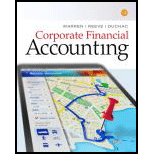
Corporate Financial Accounting
14th Edition
ISBN: 9781305653535
Author: Carl Warren, James M. Reeve, Jonathan Duchac
Publisher: Cengage Learning
expand_more
expand_more
format_list_bulleted
Question
Chapter 8, Problem 8DQ
To determine
Note receivable:
Note receivable refers to a written promise for the amounts to be received within a stipulated period of time. This written promise is issued by a debtor or borrower to lender or creditor. Notes receivable is an asset of a business.
Interest on note:
Interest on note is the amount charged on the principal value of note for the privilege of borrowing money. Interest is to be paid by the borrower and to be received by the lender.
To check and explain: Whether interest would be amounted to $5,100, if the principal value of the note is $85,000 and interest rate is 6%.
Expert Solution & Answer
Want to see the full answer?
Check out a sample textbook solution
Students have asked these similar questions
HELP
Need answer
Company A has the following data:
• Days in inventory: 18 days
Days in accounts receivable: 12 days
• Days in accounts payable: 20 days
Company B has:
• Days in inventory: 22 days
• Days in accounts receivable: 15 days
• Days in accounts payable: 30 days
What is the cash-to-cash cycle time for Company A and
Company B?
Chapter 8 Solutions
Corporate Financial Accounting
Ch. 8 - What are the three classifications of receivables?Ch. 8 - Dans Hardware is a small hardware store in the...Ch. 8 - What kind of an account (asset, liability, etc.)...Ch. 8 - After the accounts are adjusted and closed at the...Ch. 8 - A firm has consistently adjusted its allowance...Ch. 8 - Which of the two methods of estimating...Ch. 8 - Neptune Company issued a note receivable to...Ch. 8 - Prob. 8DQCh. 8 - The maker of a 240,000, 6%, 90-day note receivable...Ch. 8 - Prob. 10DQ
Ch. 8 - Direct write-off method Journalize the following...Ch. 8 - Allowance method Journalize the following...Ch. 8 - Percent of sales method At the end of the current...Ch. 8 - Analysis of receivables method At the end of the...Ch. 8 - Note receivable Prefix Supply Company received a...Ch. 8 - Prob. 8.1EXCh. 8 - Prob. 8.2EXCh. 8 - Entries for uncollectible accounts, using direct...Ch. 8 - Entries for uncollectible receivables, using...Ch. 8 - Entries to write off accounts receivable Creative...Ch. 8 - Providing for doubtful accounts At the end of the...Ch. 8 - Prob. 8.7EXCh. 8 - Aging of receivables schedule The accounts...Ch. 8 - Estimating allowance for doubtful accounts Evers...Ch. 8 - Adjustment for uncollectible accounts Using data...Ch. 8 - Estimating doubtful accounts Outlaw Bike Co. is a...Ch. 8 - Entry for uncollectible accounts Using the data in...Ch. 8 - Entries for bad debt expense under the direct...Ch. 8 - Entries for bad debt expense under the direct...Ch. 8 - Effect of doubtful accounts on net income During...Ch. 8 - Effect of doubtful accounts on net income Using...Ch. 8 - Entries for bad debt expense under the direct...Ch. 8 - Entries for bad debt expense under the direct...Ch. 8 - Determine due date and interest on notes Determine...Ch. 8 - Entries for notes receivable Valley Designs Issued...Ch. 8 - Entries for notes receivable The series of five...Ch. 8 - Entries for notes receivable, including year-end...Ch. 8 - Entries for receipt and dishonor of note...Ch. 8 - Entries for receipt and dishonor of notes...Ch. 8 - Receivables on the balance sheet List any errors...Ch. 8 - Allowance method entries The following...Ch. 8 - Aging of receivables; estimating allowance for...Ch. 8 - Compare two methods of accounting for...Ch. 8 - Details of notes receivable and related entries...Ch. 8 - Notes receivable entries The following data relate...Ch. 8 - Sales and notes receivable transactions The...Ch. 8 - Allowance method entries The following...Ch. 8 - Aging of receivables; estimating allowance for...Ch. 8 - Compare two methods of accounting for...Ch. 8 - Details of notes receivable and related entries...Ch. 8 - Prob. 8.5BPRCh. 8 - Sales and notes receivable transactions The...Ch. 8 - Continuing Company AnalysisAmazon: Accounts...Ch. 8 - Ralph Lauren: Accounts receivable turnover and...Ch. 8 - Prob. 8.3ADMCh. 8 - Prob. 8.4ADMCh. 8 - Ethics In Action Bud Lighting Co. is a retailer of...Ch. 8 - Communication On January 1, Xtreme Co. began...
Knowledge Booster
Learn more about
Need a deep-dive on the concept behind this application? Look no further. Learn more about this topic, accounting and related others by exploring similar questions and additional content below.Similar questions
- Apex Manufacturing is reviewing its working capital efficiency. The company had credit sales of $500,000 last year. Its inventory turnover was 8 times, and its Days Sales Outstanding (DSO) was 36 days. The cost of goods sold for the year was $400,000, and the payables deferral period was 30 days. Assume a 365-day year. Calculate Apex's cash conversion cycle. Round your final answer to two decimal places.arrow_forward???!arrow_forwardPlease need help with this financial accounting questionarrow_forward
- need help to solove itarrow_forwardI need answer this accounting problem todayarrow_forwardBeacon Manufacturing buys a delivery van for $48,000 at the start of the year. The van is expected to last 4 years and have a salvage value of $8,000. What is the depreciation expense per year under the straight-line method?arrow_forward
arrow_back_ios
SEE MORE QUESTIONS
arrow_forward_ios
Recommended textbooks for you
 Excel Applications for Accounting PrinciplesAccountingISBN:9781111581565Author:Gaylord N. SmithPublisher:Cengage LearningPrinciples of Accounting Volume 1AccountingISBN:9781947172685Author:OpenStaxPublisher:OpenStax College
Excel Applications for Accounting PrinciplesAccountingISBN:9781111581565Author:Gaylord N. SmithPublisher:Cengage LearningPrinciples of Accounting Volume 1AccountingISBN:9781947172685Author:OpenStaxPublisher:OpenStax College

Excel Applications for Accounting Principles
Accounting
ISBN:9781111581565
Author:Gaylord N. Smith
Publisher:Cengage Learning

Principles of Accounting Volume 1
Accounting
ISBN:9781947172685
Author:OpenStax
Publisher:OpenStax College
7.2 Ch 7: Notes Payable and Interest, Revenue recognition explained; Author: Accounting Prof - making it easy, The finance storyteller;https://www.youtube.com/watch?v=wMC3wCdPnRg;License: Standard YouTube License, CC-BY